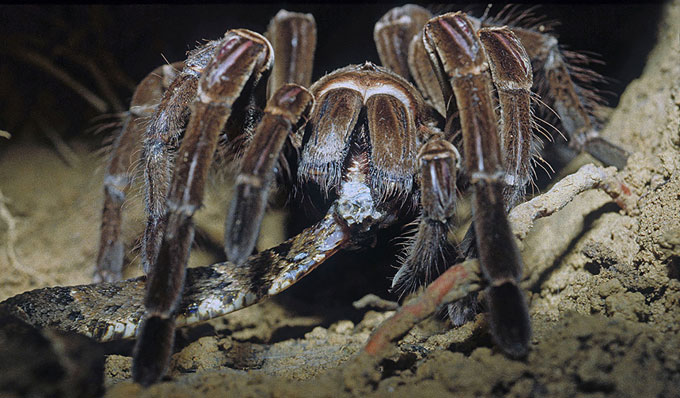A look at “Goliath Birdeater: The Amazon Giant Spider” In the mysterious world of arachnids, few creatures evoke awe and fascination quite like the Goliath Birdeater. Aptly named, this massive spider is known for its impressive size, astonishing behaviors, and unique adaptations.
In this article, we will delve into the fascinating world of the Goliath Birdeater, exploring its characteristics, habitat, hunting strategies, and its place in the natural ecosystem.

Physical Characteristics
The Goliath Birdeater, scientifically known as Theraphosa blondi, is the largest spider species in the world. Females can reach an astonishing leg span of up to 12 inches, making them the giants of the arachnid realm. These spiders possess a robust and intimidating appearance, with a hairy body and long, thick legs. Their bodies are predominantly dark brown or black, serving as effective camouflage in their natural habitat.
See Also | South American Tapir: The Amazon’s Large Herbivore
Habitat and Distribution
Native to the rainforests of northern South America, the Goliath Birdeater inhabits regions such as Venezuela, Brazil, and Suriname. These spiders prefer humid environments, with their burrows found in the forest floor. The rainforests’ moist and tropical conditions provide an ideal habitat for their survival.
Feeding Habits
Contrary to its name, the Goliath Birdeater doesn’t primarily feed on birds. While they occasionally prey upon small birds, their diet mainly consists of insects, earthworms, and other invertebrates. Their hunting technique involves lurking near the entrance of their burrow or actively patrolling their territory, detecting vibrations that indicate potential prey. Once an unsuspecting victim ventures close, the spider swiftly strikes, injecting venom and immobilizing its prey.
READ RELATED: Alyssa Wapanatahk – Age, Height, Wiki, Net Worth, Husband, Ethnicity
Life Cycle and Reproduction
The life cycle of the Goliath Birdeater begins with courtship rituals performed by the male spider to gain the female’s acceptance. After mating, the female constructs a silk-lined burrow where she deposits her eggs. She guards the egg sac ferociously until the spiderlings emerge. The young spiders undergo multiple molting stages as they grow, shedding their exoskeletons to accommodate their increasing size.
Defense Mechanisms
To defend itself from predators and other threats, the Goliath Birdeater possesses a set of remarkable defense mechanisms. When threatened, they can release a cloud of irritating hairs from their abdomen, causing discomfort and potentially blinding the attacker. Additionally, their large size acts as a deterrent, discouraging potential predators from engaging in a confrontation.
Interaction with Humans
The Goliath Birdeater’s enormous size and fearsome appearance have captivated the interest of many arachnid enthusiasts. Some people keep them as exotic pets, although their complex care requirements make them unsuitable for inexperienced owners. It is important to note that, despite their intimidating size, these spiders are generally docile and only bite when provoked.
Conservation Status
Due to their restricted habitat and slow reproductive rate, the Goliath Birdeater faces certain conservation concerns. Habitat destruction and illegal collection for the pet trade pose significant threats to their populations. It is crucial to implement conservation measures to protect their natural habitat and raise awareness about the importance of preserving these unique creatures.
Conclusion
The Goliath Birdeater, with its massive size and intriguing characteristics, remains a captivating wonder of the natural world. From its impressive physical attributes to its hunting strategies and defense mechanisms, this giant spider showcases the diversity and complexity of nature. While often misunderstood and feared, the Goliath Birdeater plays a vital role in maintaining the delicate balance of ecosystems it inhabits. By understanding and appreciating these fascinating arachnids, we can foster a greater respect for the incredible diversity of life on our planet.
FAQs
- Q: Is the Goliath Birdeater venomous? A: Yes, the Goliath Birdeater possesses venom, but its bite is not considered life-threatening to humans.
- Q: Are Goliath Birdeaters aggressive towards humans? A: Generally, Goliath Birdeaters are docile and prefer to retreat rather than engage in aggressive behavior towards humans.
- Q: How long do Goliath Birdeaters live? A: The lifespan of Goliath Birdeaters can range from 10 to 15 years, depending on various factors such as gender and habitat conditions.
- Q: Can Goliath Birdeaters be kept as pets? A: While some individuals keep Goliath Birdeaters as pets, they require specific care and environmental conditions, making them more suitable for experienced keepers.
- Q: Are Goliath Birdeaters endangered? A: While not currently listed as endangered, the Goliath Birdeater faces threats such as habitat loss and illegal collection, making conservation efforts crucial for their long-term survival.
See Also | Green Anaconda Vs Giant Anaconda: Which One is bigger And What’s the Difference?




